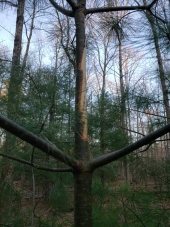posted 9 years ago
Pictures would help, but it sounds like you have a similar problem as me: a mature forest. Myself, I am not a big fan of clearcutting, instead preferring to do "circle cutting" as a method to obtain diversity...or saplings if you will. I simply go into a stand, drop the trees into a circle of say 50-75 feet in diameter and then move on to another area. Over time, those areas grow up and then I can go back in on the fringes and do the same thing again. By doing so, I provide habitat for rabbit, moose and bear; just to name a few, but also gain income from forestry products. This is an approved forestry technique and my forest is certified under the American Tree Farm System and the Forest Stewardship Council...a far more involved woodland certification process, so there is nothing wrong with this method of logging.
Another method that works well, but one I am slow to adopt, is the Shelterwood Method. This removes all but the biggest trees in a given area and is done on a year where they produce cones so the mature trees can germinate new ones. In my area it is typically done for White Pine. With all but the biggest trees gone, the wood sprouts up and then after the new forest is established, the mature trees are taken out; about a decade later. It really works well for White Pine, but not so well for hemlock (more on that in a moment). The two things I dislike about the Shelterwood method is that you MUST cut hard...almost to clearcut like status...I dislike that look. Also you must scarify the earth so that the seeds can settle in and germinate. I have a bulldozer so that is easy, but it seems counterproductive to kill other saplings just to get a single species from the mature trees.
Now in regards to Eastern Hemlock...
Another issue you may have, especially being from PA since it is the state with the most...is that you have hemlock stands. I have hundreds of acres and yet one in four trees is a Eastern Hemlock. (25%-YIKES!) I like the properties of the wood, however getting that type of tree to establish itself is problematic. Just to germinate, the seed must fall on exposed soil and not dry out within 6 hours of falling, or the seed is toast. That is pretty hard to do. Then it requires shade! Saplings can live in shade for years, only to start growing after the mature trees above it dies and finally allows in light. And Hemlock trees are the old timers of the forest, some are 300-400 years old on my farm. They just refuse to die. They are such a difficult tree species to manage for that the USDA-NRCS does not even try to. My forest plan, despite having 25% hemlock, has no mention of managing for hemlock despite the ideal conditions for it.
As for a recommendation: I would not clearcut. I tried a small section on a hardwood ridge and even my forester was taken back by the amount of deer damage done to the saplings trying to come up. I had NONE! I would hold back on the Shelterwood Method as well unless I really, really had advice from a good Forester telling you to do so, but will instead suggest the circle cutting method.
If I get a chance I will head into my woodlot later (right now I am watching my 2 year old until my wife comes back from grocery shopping), and take some photos of the results of circle cutting. The diversity is immense and really has been successful. The difference between what I have yet to circle cut (the fringes) and where I have not, is so striking, I honestly think you will be impressed.















 1
1




 1
1






































